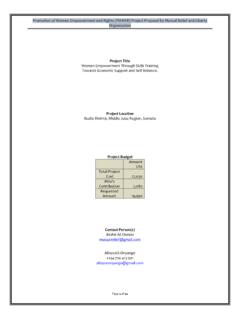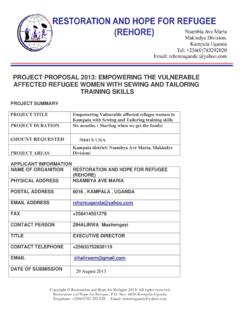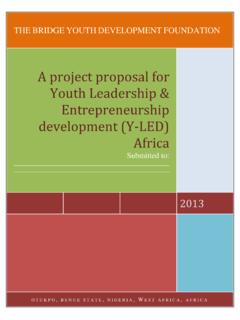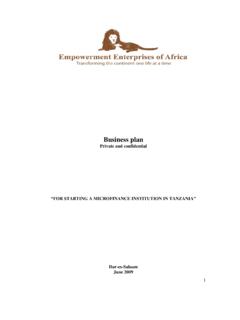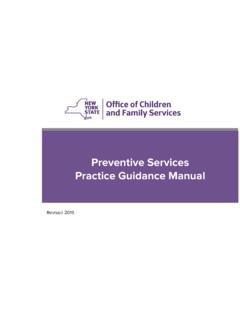Transcription of Early Childhood Education Training Manual for Educators
1 2 Early Childhood Training Manual for Educators Contents Introduction to the Training Manual .. 3 Getting Ready .. 4 Training MODULES Introductory Session .. 7 Key Lesson I: Key Learning Areas and Competencies .. 14 Key Lesson II: Techniques for Planning and Key-Lesson III: Child-Centered Approaches .. 41 Key Lesson IV: Participatory Strategies in Early Childhood Education .. 50 Key Lesson V: Working with Parents and 57 Key Lesson VI: Children Affected by Conflict and Violence .. 64 Closing: Being a Visionary Educator .. 73 Sources .. 76 Appendices Preschool Teacher Needs Assessment Evaluation .. 77 Pre- Training Evaluation .. 81 Post- Training Evaluation .. 83 Worksheets for Planning and Reflection.
2 85 Worksheets for Observation .. 91 Safety Guidelines for Early Childhood Centres .. 93 3 Introduction to the Training Manual This curriculum is aimed at the years prior to children attending formal schooling, which generally starts at the age of six depending on the individual situation of each child. The purpose of this document is to help Timorese Educators make informed decisions about curriculum content and pedagogical approaches in Early Childhood Education . The guidelines are based on theory and research about how children develop and learn; they reflect the growing consensus among Early Childhood professional organizations that a greater emphasis needs to be placed on young children s learning abilities, acquisition of basic skills, child-centered approaches and participation in meaningful and relevant learning experiences.
3 Thus, this Manual combines theory with practical examples of participatory and child-centered approaches to learning and Education with a special focus on the particular context of Timor-Leste. Additionally, it provides Educators with possibilities to reflect on their own working styles and perspectives while further developing their teaching skills and capacities. This Manual focuses on the specific needs, capacities and vulnerabilities of the children the Educators are working with. The intent is to ensure that all children have the opportunity to fully develop their capacities. Due to age differences and previous experiences, however, children will have different levels and areas of knowledge.
4 Children s current strengths and skills should serve as the starting point for new experiences and instruction, rather than become a limitation to learning. If there is not enough time to work through every step, please feel free to cut out some activities or adapt them according to the possible time frame, needs and interests of the participants. Suggestions and feedback on the Manual are welcome! Written and published by: NGO Ba Futuru Ba Futuru Peace Centre, Golgota, Comoro Road, Dili, Timor-Leste +670 3322437 Translation from English to Tetun by: Hector Hill Photography: Julia Scharinger (copyright) Edition 1 published in 2012 4 Getting Ready Preparation for Training : Before starting Training with this Manual it is important to be prepared.
5 Not only does each child vary in its needs and interests, but the Educators that you will be working with also vary. Find out as much as possible about the needs and interests of the specific Training participants before the Training begins, either through casual conversation or through the Preschool Teacher Needs Assessment in the Appendices of this Manual . Take some time to talk to the teachers and ask them the questions in the Evaluation Form. Based on the information you receive, review the contents of this Manual and choose or adapt the sections according to your Training participants needs. For example, you can use the Introductory Session with one or two Key Lessons and the Closing Session.
6 Depending on the available time you can use all exercises and games or just select some. Also, in the Manual you will find a lot of suggestions for rituals and feedback-rounds. Choose only one ritual per Training and do not do a feedback-round after every session, but instead after every day or after the whole Training . If you are provided with the option of visiting and observing the preschools your participants work in either as part of your preparations or as some sort of mentoring following the trainings, please keep in mind that some teachers might feel uncomfortable being observed in their daily work. Therefore it is important to present yourself as their partner.
7 Emphasize that you are there to support their work rather than to control or judge them. Additionally, it is suggested to reflect together on what happens during your time in the preschool. This does not only increase trust, but also provides you with the possibility to ask questions and gain more insights on the perspectives and working styles teachers currently use, before you begin the Training with them. About facilitating: As a facilitator you have a unique and important role within the group you are working with. However, you are not the person in charge, a lecturer or the unquestionable expert. In fact, it is the participants who work with children on an everyday basis and who have a great amount of knowledge, expertise and insights on the challenges children face in Timor-Leste.
8 It is your job to create an environment where your knowledge and the knowledge of the Early Childhood Educators can be combined in order to introduce or strengthen child-centered and participatory teaching approaches and to reinforce the use of positive discipline. Keep in mind that people do not only learn with their mind or intellect, but also through their actions, their feelings and personal reflections. As a facilitator you should choose teaching methods, which holistically include the participants and create a space that is based on mutual respect, curiosity and ownership. The participants should be the protagonists of this space while you are an attentive, supportive and encouraging partner in learning.
9 Be aware that people learn a lot by observing others you do not only teach by presenting information from this Manual but also by example with your own appearance, manner and body language! 5 Checklist for facilitators: Be prepared Approach participants thoughtfully and find out about their learning aims regarding the Training . Review the material to be covered and prepare a flexible agenda Prepare the material you need for your Training in advance and arrive Early so you have time to collect your thoughts, prepare the meeting space and welcome the participants. Be a partner Reduce hierarchical approaches, and instead adopt inclusive, participatory and democratic principles.
10 Be careful that both the content and learning process reflect open-mindedness and mutual respect. For example, do not use highly complex or scientific language, avoid simple answers to complex questions, do not hesitate to acknowledge you don t know everything and listen to what the participants have to say (including their body language). Do not stand in front of the participants, but create a circle, sit on a chair or on the ground and talk to them at the same eye level. Be aware Be sensitive to the feelings of individuals, to body language and to group dynamics. Make sure everyone feels appreciated and equal in the group and be flexible and creative according to the participants needs and wants.
